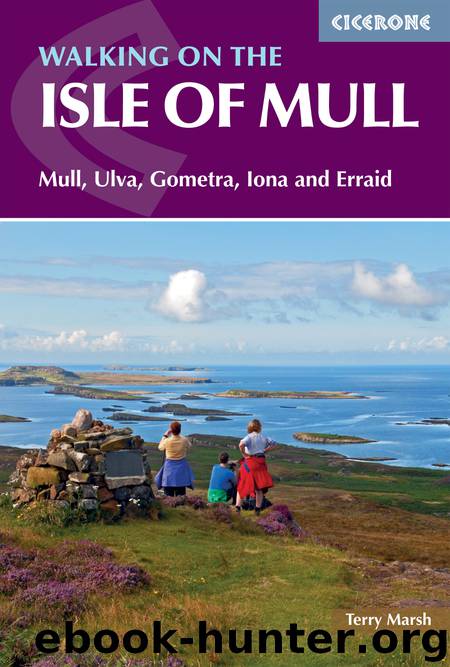The Isle of Mull by Terry Marsh

Author:Terry Marsh
Language: eng
Format: epub
ISBN: 9781783625604
Publisher: Cicerone Press
Published: 2017-06-10T04:00:00+00:00
Cross the ancient bridge spanning the Allt Teanga Brideig and immediately turn left to a gate, beyond which the old path sets about the lower slopes of Corra-bheinn, zigzagging a little to ease the ascent. In dry or frozen conditions, the walk up to the bealach is magnificent, but there is usually enough water about to call for nimble footwork to avoid the worst clutches. The path, however, remains continuous and clear throughout.
Further up, Torr na h-Uamha seems to present an obstacle, but the path passes to its left once you cross the Allt Coir’ an t-Sailein, and then it is plain sailing up to the bealach, Mam Clachaig, just east of Creag MhicFhionlaidh. Here you find a modest cairn, Carn Cul Righ Albainn, which translates as ‘the cairn with its back to Scotland’, an allusion to the legend that the pass formerly marked the boundary between the Picts and the Scots.
Ahead you step into the beautiful glacial Glen Clachaig, a superb, smooth-profiled defile. On the far side, the southern end of Beinn Fhada is shapely and inviting, while off to the left, the slope leads up to the cone of A’ Chioch.
From Carn Cul Righ Albainn, the route turns down into Glen Clachaig, a clear path showing the way, but it is heavy going at times, in spite of a continuous path that eventually leads down to intercept the glen river. There is no advantage in descending sooner to the river; better to maintain faith with the path, which, in spite of its moments of boggy doubt, is merely typical of the sort of terrain you get across much of Scotland.
MAM CLACHAIG
This high pass is the route used by cattle drovers bringing cattle not only from Mull but from the islands of Coll and Tiree. Trade in cattle from Argyll existed from the time of Mary Queen of Scots, but it was not a task free from hazard, if the number of cases of cattle theft dealt with by the Privy Council during the 16th and 17th centuries is anything to go by. Notwithstanding, during the main droving period in the 18th and early 19th centuries, Mull continued to be one of the principal sources of droving cattle, numbering, with those from neighbouring islands, as many as 2000 head of cattle per year. The cattle were shipped from Mull at Grass Point at the mouth of Loch Don to the island of Kerrera. Even at the end of the 18th century, Oban was, as Dr Johnson described, ‘only a small village if a few houses can be so described’, so the cattle were taken to Kerrera, from where they swam the narrow channel to the mainland.
Download
This site does not store any files on its server. We only index and link to content provided by other sites. Please contact the content providers to delete copyright contents if any and email us, we'll remove relevant links or contents immediately.
In a Sunburned Country by Bill Bryson(2948)
Annapurna by Maurice Herzog(2839)
How to Read Nature by Tristan Gooley(2665)
Dangerous Girls by Haas Abigail(2469)
The Lost Art of Reading Nature's Signs by Tristan Gooley(2283)
SAS Survival Handbook by John 'Lofty' Wiseman(2260)
In the Woods by Tana French(1997)
Food and Water in an Emergency by Food & Water In An Emergency(1992)
The Stranger in the Woods by Michael Finkel(1924)
Guns, Germs and Steel by Diamond Jared(1884)
Everest the Cruel Way by Joe Tasker(1827)
Backpacker the Complete Guide to Backpacking by Backpacker Magazine(1815)
Sea Survival Handbook by Keith Colwell(1796)
Ultimate Navigation Manual by Lyle Brotherton(1768)
Trail Magic by Trevelyan Quest Edwards & Hazel Edwards(1760)
Wild: From Lost to Found on the Pacific Crest Trail by Cheryl Strayed(1736)
Birds of the Pacific Northwest by Shewey John; Blount Tim;(1604)
Welcome to the Goddamn Ice Cube by Blair Braverman(1601)
Portland: Including the Coast, Mounts Hood and St. Helens, and the Santiam River by Paul Gerald(1581)
